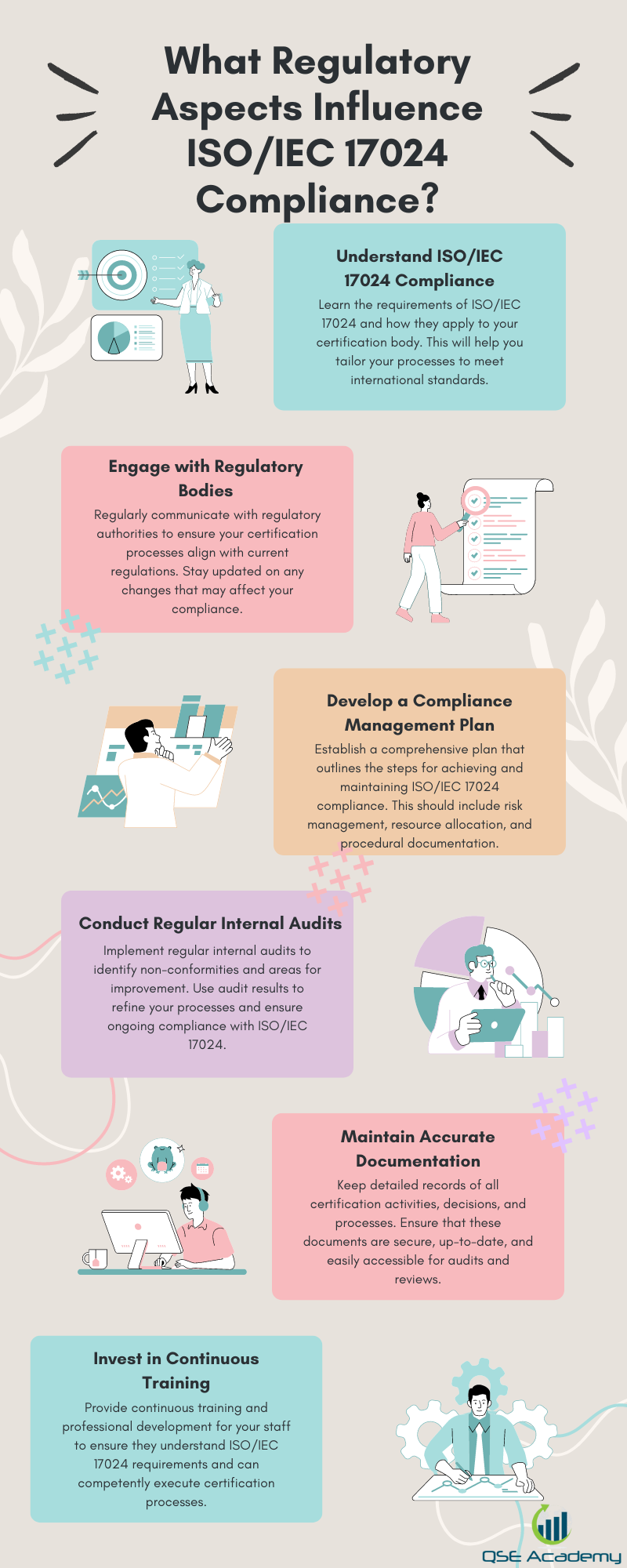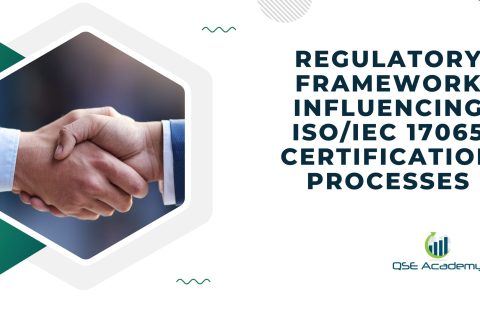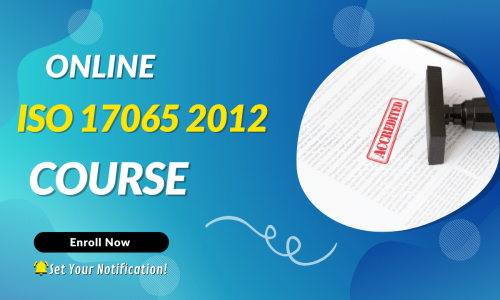What Regulatory Aspects Influence ISO/IEC 17024 Compliance?
Imagine a world where credentials are universally trusted and the certification of professionals is globally consistent. ISO/IEC 17024 compliance aims to make this a reality. ISO/IEC 17024 provides a benchmark for bodies operating certification of persons, ensuring that they operate in a consistent, comparable and reliable manner worldwide. In our interconnected global economy, ISO/IEC 17024 forms the keystone of professional trust and quality assurance across various industries and sectors. This introduction guides you through the regulatory maze that shapes ISO/IEC 17024 compliance, enabling certification bodies to demonstrate competence and comparability, ensuring their credentials are recognized and respected everywhere.
Introduction
ISO/IEC 17024, also known as “Conformity assessment – General requirements for bodies operating certification of persons,” is an international standard specifically designed to harmonize the certification process of personnel across various sectors. Its primary objective is to ensure that certification bodies operate in a consistent, comparable, and reliable manner, thereby fostering public confidence and integrity in the certification processes. ISO/IEC 17024 sets out criteria that organizations must meet to be recognized as competent to certify individuals, establishing a global benchmark for personnel certification.
By achieving compliance with ISO/IEC 17024, certification bodies demonstrate that they have met the rigorous requirements necessary to operate a certification program effectively. This creates a level of trust and recognition in the job market, which is valuable for both the individuals getting certified and the bodies providing certification. The focus of this article will be to outline the necessity of ISO/IEC 17024 compliance for certification bodies, the value it adds to their certification schemes, and an exploration of how it impacts the various stakeholders involved in the certification process.
Understanding ISO/IEC 17024 Compliance
ISO/IEC 17024:2012 sets the global benchmark for personnel certification, providing a framework for organizations (certification bodies) that certify individuals across a variety of professions. Its widespread adoption assists in standardizing the certification processes, ensuring that they can be uniformly recognized and respected in the job market. The core principles of ISO/IEC 17024 compliance revolve around impartiality, fairness, competence, qualification assurance, consistency, and transparency, establishing public confidence in the certification schemes.
To comply with ISO/IEC 17024, a certification body must meet several stringent requirements which can be broadly categorized into four main groups:
- Structural Requirements:
- Independence of the certification body to ensure objectivity
-
- Defined responsibilities and mechanisms to prevent conflicts of interest
- Resource Requirements:
-
- Adequate and competent staff with necessary expertise
-
- Suitable and effective resources to perform its certification activities
-
- Transparent and fair procedures for certification, including application, assessment, examination, and the decision on certification
-
- Maintaining confidentiality and security throughout the personnel certification process z
-
- Implementation of a quality management system
-
- Regular monitoring, reviewing, and improvement of the system
These rigorous standards aim to support the competence of personnel certification, thus increasing public service quality and trust. The ISO/IEC 17024 compliance framework demands conformity assessment bodies to operate with integrity and professionalism, ensuring their certification schemes meet specific requirements pertaining to the respective area of certification.
Becoming compliant is crucial for any personnel certification body looking to gain international recognition and validation. Achieving compliance not only enhances the quality and reliability of the certification services provided but also expands their scope of certification internationally. With ISO/IEC 17024 compliance, certification bodies can assure stakeholders of the high standards and comparability of the certifications, contributing significantly to the ease of mobility for certified professionals in the global job market.
Global Regulatory Frameworks Influencing ISO/IEC 17024
ISO/IEC 17024 Compliance within Global Regulatory Frameworks
The ISO/IEC 17024 standard sets a global benchmark for personnel certification bodies, ensuring that individuals are certified based on their competence to perform specific tasks. Compliance with ISO/IEC 17024 is influenced by a mosaic of international and regional regulatory bodies, as well as industry-specific requirements.
At the international level, the International Organization for Standardization (ISO/IEC) plays a pivotal role in the establishment of normative guidelines. Its influence is further bolstered by the International Accreditation Forum (IAF), which oversees accreditation bodies ensuring they adhere to international standards for certification processes.
Regionally, various regulatory bodies enforce standards harmonious with ISO/IEC 17024 to enhance public confidence and ensure quality in the certification of persons. For instance, the European Union employs regulations such as EN ISO/IEC 17024:2012, upheld by the European cooperation for Accreditation (EA). In North America, bodies like the American National Standards Institute (ANSI) provide accreditation services aligned with ISO/IEC guidelines.
Moreover, sector-specific regulations necessitate tailored compliance requirements. Notable examples include:
- Healthcare: Certification bodies must account for patient safety and healthcare delivery standards.
- Information Technology (IT): Certifications must reflect current trends in cybersecurity and data management.
- Engineering: Standards emphasize the technical proficiency and ethical grounding of engineering professionals.
In summary, ISO/IEC 17024 inteplays with a wide range of global and sector-specific regulatory frameworks to standardize the certification of persons, ensuring uniformity, trust, and recognition in diverse job markets.
National Regulatory Aspects
National Regulatory Aspects
Navigating the landscape of national regulatory requirements is fundamental for personnel certification bodies pursuing ISO/IEC 17024 compliance. These regulations can significantly differ from country to country and influence the operation and recognition of certification processes and schemes.
In the United States, organizations like the American National Standards Institute (ANSI) and the National Institute of Standards and Technology (NIST) play pivotal roles in setting the stage for compliance. ANSI, for instance, often serves as an accreditation body that adheres to ISO/IEC 17024:2012 standards, tailoring specific requirements for certification bodies within its jurisdiction.
By contrast, European Union member states might reference EN 45011, a standard that encompasses general requirements for bodies operating certification schemes. However, the degree of adoption and adaptation of this standard can lead to variability in national implementation, thus certification bodies must be thoroughly versed in each country’s approach.
The Asia-Pacific region presents its unique regulatory climate. Major economies like Japan, China, and Australia have established their own standards and requirements. For example, Japan’s Industrial Standardization Law sets a framework for personnel certification, which certification bodies must follow diligently.
Challenges in adapting to these diverse regulations include dealing with the sheer complexity and the potential for variability. Certification bodies often adopt comprehensive strategies, including thorough jurisdictional research, to ensure seamless compliance across different national frameworks.
To aid in navigating these regulatory requirements, bodies may consider the following strategies:
- Engaging with local accreditation and regulatory authorities
- Close monitoring of national standards and their amendments
- Establishing robust legal and compliance units within the certification body
In summary, national regulations play a crucial role in the successful functioning and global recognition of personnel certification bodies compliant with ISO/IEC 17024. Understanding and adapting to these varied requirements is not merely beneficial, but essential for accreditation and maintaining public confidence in certified professionals.
Legal and Ethical Considerations
In the realm of personnel certification, adherence to the ISO/IEC 17024 standard is paramount. This international standard sets forth rigorous guidelines for bodies operating certification programs, ensuring that the process is fair, reliable, and able to instill public confidence in the certification scheme. Compliance with legal and national international laws is not just obligatory—it forms the bedrock upon which trustworthy certification activities are constructed. Bodies that disregard these legalities face severe consequences, ranging from loss of accreditation to legal penalties, potentially compromising their reputation and standing in the job market.
Ethical practices are equally critical, as they underpin the integrity and credibility of the certification process. It’s essential for certification bodies to cultivate an ethical framework that guides their certification activities and decision-making processes. This includes maintaining impartiality, confidentiality, and transparency throughout the certification process, from the development of certification schemes to making a final decision on certification.
Case studies highlight the gravity of maintaining compliance and ethical conduct. Bodies that have navigated legal challenges or ethical dilemmas offer valuable insights into best practices and underscore the importance of upholding standards. By learning from these precedents, certification entities can bolster their credibility and contribute to a more competent and trustworthy workforce.
Ethical Framework Table:
| Principle | Description |
| Impartiality | Avoiding conflicts of interest and ensuring objectivity |
| Confidentiality | Protecting personal and proprietary information |
| Transparency | Providing clear, accessible information about certification processes |
Best Practices List:
- Regularly update legal compliance protocols
- Engage in ongoing staff training on ethical considerations
- Implement a transparent grievance and appeals process
- Maintain strict confidentiality measures for all candidates
- Monitor and enforce impartiality at every stage of certification
Remaining aware of legal obligations and committed to ethical standards, certification bodies can foster a climate of trust and foster advancements in various professional fields.
Compliance Management Strategies
To ensure adherence to standards such as ISO/IEC 17024, a robust compliance framework is indispensable. This framework comprises various key components, primarily starting with a defined scope of certification and transparent certification processes tailored to the respective certification schemes.
Key Components:
- Articulating policies and procedures reflective of ISO/IEC 17024 requirements.
- Designating responsibilities among personnel to foster a diligent certification body environment.
- Developing a risk management strategy to address potential deviations from the set standards.
Developing and implementing the framework necessitates a stepwise approach; for instance:
- Conducting a gap analysis against ISO/IEC 17024:2012 standards,
- Addressing identified gaps with corrective measures,
- Integrating certification activities within the organization’s processes, and
- Ensuring an accreditation process is in place for external validation.
The significance of training and awareness programs cannot be overstated. These programs cultivate and maintain public confidence in certification processes. Effective strategies include:
- Regularly scheduled training sessions,
- Engaging learning materials to enhance understanding, and
- Periodic updates on new developments in the job market or certification processes.
When it comes to continuous monitoring and improvement, methods employed involve:
- Regular internal audits,
- Stakeholder feedback mechanisms, and
- Analysis of compliance trends over time.
The evolution of technology has revolutionized the way compliance management is handled. With the availability of specialized tools and software for compliance tracking, certification bodies can enjoy numerous benefits such as:
- Easier tracking of certification and recertification cycles, and
- Streamlined decision-making processes for certification.
In conclusion, the compliance management strategies underscore are the critical role of integrating a comprehensive framework, continuous personnel training, and technology utilization to satisfy ISO/IEC 17024 compliance requirements, thereby maintaining a high-quality, internationally-recognized benchmark for personnel certification.
Best Practices for Ensuring ISO/IEC 17024 Compliance
ISO/IEC 17024 compliance is paramount for certification bodies involved in the certification of persons to ensure their processes are recognized internationally. The ISO/IEC 17024:2012 standard outlines requirements for a certification body’s structure, operations, and evaluation methods to ensure competency. Here are some best practices for ensuring compliance:
Engaging with Regulatory Bodies: Establishing and nurturing a constructive relationship with regulators is essential. Effective communication, regular engagement through updates, and meetings can help smooth the certification process. Demonstrating a commitment to quality and compliance builds trust and reduces the likelihood of serious compliance issues.
Documentation and Record-Keeping: Accurate record-keeping is the backbone of ISO/IEC 17024 compliance. Good practices include maintaining detailed records of certification decisions, candidate evaluations, and the certification schemes employed. Records must be secure and accessible, per the standard’s requirements, and serve as evidence of compliance during audits.
Internal Audits and Assessments: Regular internal audits are a necessity, not just for identifying non-conformities but also for process improvement. The goal is to preemptively address potential issues before they escalate.
Stakeholder Involvement: Engage stakeholders—this not only includes staff and management but also customers and other interested parties. Their feedback can provide valuable insights into how the certification process can be refined to better serve all parties involved.
To keep track of these practices, a simple table can be employed:
| Best Practice Area | Key Actions |
| Regulatory Bodies | – Engage regularly |
| – Communication updates | |
| Documentation | – Maintain accurate records |
| – Secure storage methods | |
| Internal Audits | – Conduct regular audits |
| – Use results for process improvement | |
| Stakeholder Involvement | – Engage for feedback |
| – Incorporate insights into processes |
By adhering to these guidelines, a certification body enhances its credibility and strengthens public confidence in its certification processes, thus ensuring that its certification programs maintain a high level of quality and integrity. Employing these best practices helps certification bodies meet not only the detailed requirements of ISO/IEC 17024 but also the expectations of the job market and respective certification schemes.
Conclusion
In conclusion, adherence to ISO/IEC 17024 is paramount for certification bodies that wish to establish public confidence in their certification processes and the competence of the individuals they certify. A thorough approach to compliance with this international standard ensures that personnel certification bodies are recognized for their rigor, credibility, and reliability. With the criteria laid out in ISO/IEC 17024:2012, the integrity of the certification process is supported by clear guidelines which cover the development, implementation, and maintenance of a certification scheme for persons.
Organizations within various sectors are encouraged to prioritize compliance to ISO/IEC 17024 to not only enhance their competitive advantage in the job market but also to facilitate the continuous improvement and development of professional standards. As the regulatory landscape evolves, it is expected that personnel certification will become increasingly essential, setting a benchmark for validating skills and knowledge in an ever-specializing workforce.
Looking toward the future, certification bodies should remain agile, updating and refining their certification schemes to align with emerging trends and regulatory changes. Embracing ISO/IEC 17024 compliance will enable organizations to sustain and boost public trust and meet the dynamic demands of global competency assurance.
Looking for More Resources on ISO 17024?
If you found this article helpful, explore our premium resources designed to help you achieve ISO 17024 certification efficiently:
- 📦 Complete Documentation Package for ISO/IEC 17024 2012: Get all the essential templates and documents you need for fast, easy implementation.
- 🎓 Online Course on ISO/IEC 17024 2012 : Enroll in our comprehensive training to master the key concepts and practical steps toward certification.
- 📋 ISO/IEC 17024 2012 Checklist: Download our detailed checklist to ensure you’ve covered every step of the process.
These resources are tailored to meet your needs and ensure a smooth certification journey. Explore them today and get one step closer to success!
























